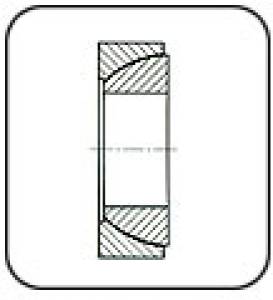Description
Angular & Axial Contact: Achieving Precision and Stability in Mechanical Systems
This comprehensive guide explores the critical concepts of angular and axial contact within mechanical systems, detailing their functionalities, applications, and design considerations. Understanding these contact types is crucial for engineers designing high-precision, high-load, and high-speed machinery.
Understanding Angular Contact
Angular contact refers to the situation where two components, typically bearing surfaces, make contact at an angle, rather than directly facing each other. This angled contact allows for the efficient handling of both radial (perpendicular to the shaft) and axial (along the shaft) loads. Key characteristics include:
- Load Distribution: The angled contact distributes loads more effectively than purely radial contacts, improving bearing life and reducing stress concentrations.
- Directional Load Capacity: Angular contact bearings excel at handling combined radial and axial loads in a specific direction. The direction is determined by the angle of contact.
- Preloading: Angular contact bearings can be preloaded, meaning a small initial force is applied to eliminate clearance and enhance stiffness. This results in improved accuracy and reduced vibration.
- High Speed Capabilities: Properly designed angular contact bearings can operate at high speeds due to efficient load distribution and minimized friction.
- Applications: Angular contact bearings are prevalent in high-precision applications like machine tools, robotics, aerospace components, and high-speed spindles.
Understanding Axial Contact
Axial contact, also known as thrust contact, occurs when two components interact primarily along their axes. This type of contact is designed to resist axial loads – forces pushing or pulling along the direction of the shaft. Key characteristics include:
- Pure Axial Load Handling: Axial contact bearings are specifically designed to withstand significant axial forces.
- Limited Radial Load Capacity: While some axial contact bearings can tolerate minor radial loads, their primary function is to manage axial forces.
- Thrust Bearings: Dedicated thrust bearings are designed for purely axial loads. These come in various configurations, including ball thrust bearings, roller thrust bearings, and hydrodynamic thrust bearings.
- Applications: Axial contact is vital in applications involving significant axial loads, such as vertical shafts, rotating equipment subjected to end thrust, and linear actuators.
Combining Angular and Axial Contact: Hybrid Systems
Complex mechanical systems often require handling both radial and axial loads simultaneously. This is where a combination of angular and axial contact designs becomes crucial. This might involve:
- Using a combination of angular contact bearings and thrust bearings: This approach provides optimized support for both radial and axial loads.
- Designing components with integrated angular and axial contact surfaces: This creates a more compact and integrated solution.
Design Considerations
Proper design and selection of angular and axial contact systems demand attention to several critical factors:
- Load Magnitude and Direction: Accurately determining the magnitude and direction of loads is essential for selecting appropriate bearing types and sizes.
- Speed and Operating Conditions: Operating speed, temperature, and environmental factors heavily influence bearing selection and lifetime.
- Material Selection: Material compatibility, hardness, and wear resistance are vital for long-term performance.
- Lubrication: Proper lubrication is essential to minimize friction and extend bearing life.
- Tolerance and Clearance: Precise tolerance control is necessary to ensure proper alignment and performance.
This comprehensive guide provides a foundational understanding of angular and axial contact in mechanical systems. By carefully considering the presented concepts, engineers can design reliable, high-performance systems capable of meeting the demands of diverse applications.
